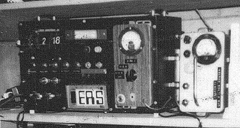|
The
 Project
Multiple
Anomaly Detection & Automated Recording
Francis Ridge,
Director UFO Filter
Center, 618 Davis Davis Drive, Mt. Vernon, IN
47620
Mt. Vernon, IN 47620. 1970-1991
Abstract Report
The NICAP UFO EVIDENCE (1964) lists
106 instances which are included in the Group 3 or
Category 3 list, of UFOs apparently producing
"electromagnetic effects". E-M Effects are those
which disrupt electrical circuits, cause engine
failure in automobiles, produce radio
interference, etc. Included in the E-M category
are reports of compass needle deviations. See
also, the Cartwright UFO Detector.In 1981, Mark Rodeghier
completed his study for the Center for UFO
Studies. This study is an examination, chiefly
through statistical means, of the subclass of
UFO events wherein the car, truck, or other
motor vehicle in which a witness was either
riding or in near proximity to, was seemingly
affected by the presence of a UFO. It includes a
full catalog of 441 cases.
Concentrating my research to a category, the project was designed to demonstrate that UFOs were not only witnessed by reliable observers, but also by electronic devices which cannot hallucinate. The purpose of the project was two-fold: 1) To act as an early warning system for the presence of electromagnet and magnetic anomalies and early visual anomalistic target acquisition. Data would be acquired by automatic & manually-operated devices. The experiment would allow trained personnel to possibly observe a UFO and conduct scientific experiments during an event. 2) The data, to be incorporated into a regional computer database, could provide possible correlations with visual (and hopefully radar) sightings on a regional level. The detection system, which later became known as MADAR (Multiple Anomaly Detection & Automatic Recording), was designed by Lewis G. Blevins & Francis L. Ridge in 1960. All but two years of
the operational period involved monitoring at a
single isolated area, at Mt. Vernon, Indiana. The
site was located in an area north of the city,
isolated from disturbance sources, save lightning,
and earthquakes, and ....UFOs.
In early 1973, as
State-Section Director for MUFON, Francis Ridge
made initial in-person contacts with law
enforcement people and airport control tower
operators, attempting to set up a reporting
system. The timing was good. The 1973 wave helped
to stimulate cooperation among those who didn't
want to be burdened with UFO calls and/or didn't
have the time or need to follow them up. To
maintain the rapport, a Monthly Status Report was
sent to police, sheriff, state police and control
tower people in the three county area. In 1986
this monthly report became a State Report for all
UFO Field Investigators and State-Section
Directors in Indiana. Every opportunity to use the
news media, periodically, provided the local
readers and viewers with a 24-hotline number.
Local member and
non-member personnel who helped the Center
identify reported UFOs were spread throughout
Posey County were part of SKYNET. A UFO reported
in a certain area or direction facilitated a call
from the Center to this "Spotter". Kits designed
for UFO Investigation were described in the MUFON
Field Investigator's Manual, but special kits were
created at the Center and used for a "rapid
deployment group". CB radios, radiation detection
equipment, optical instruments, etc., were all
used in this effort.
Other Research Projects &
Databases
Precision Monitoring
Systems listed other instances of compass needle
movement, documented by Eric Herr in San Diego,
CA.
Ray Stanford's
PROJECT STARLIGHT INTERNATIONAL (now defunct)
recorded several UFO-related E-M disturbances, one
in which a magnetometer, a gravimeter, and a WWV
time signal deviated at the same time. The
calibration tone showed that the equipment was
operating normal. This occurred on July 19, 1978
with two UFOs filmed.
Another series of
experiments with the magnet variometers was
conducted in New Hampshire between November 1970
and September 1972. David Webb and John Oswald
logged 22 good events out of 659 with 13 detector
sites. The sensitivity in these cases was very
high, with no way of analyzing the data such as
magnitude or duration. In 1971, William Hunkins
gave a paper to the 1971 Midwest UFO Conference.
It must be made
clear that once the "sensor" is isolated from all
other natural or man-made E-M sources, the very
small reading one is left with is simply the
Earth's own magnetic field. What we are then
looking for is something distorting that field.
Since the Earth's magnetic field doesn't vary more
than 5 per cent from its static average, the
"background" is perfect. "The classic magnet
variometer is a mechanical sensor...besides
tending to be simple in construction and
operation, mechanical sensors offer a bonus that
helps improve the signal-to-noise ratio. They tend
to be unresponsive to high frequency fields, which
is good; we are only interested in slow changes in
the steady field." The resolution is typically 0.1
gamma.
It was the MADAR
Project Director's hope that both magnet
variometers and electronic magnetometers would be
used simultaneously in the project, just as were
two types of radiation detectors to check the
integrity of the data for alleged unusual nuclear
radiation. However, a magnetometer was never built
or purchased. In spite of this, the data gleaned
from the study was very interesting and
surprising, even in the preliminary stages. (See The MADAR Records)
Francis L. Ridge
Director of the
MADAR Project
|

